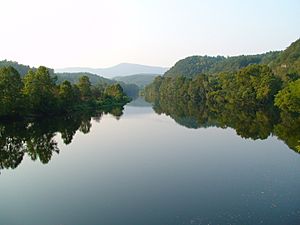Battle of The James River (1667) facts for kids
Quick facts for kids Battle of the James River (1667) |
|||||||
|---|---|---|---|---|---|---|---|
| Part of the Second Anglo-Dutch War | |||||||
 Present day James river |
|||||||
|
|||||||
| Belligerents | |||||||
| Commanders and leaders | |||||||
| Strength | |||||||
| 5 Ships | 1 Warship 21 Merchant ships |
||||||
| Casualties and losses | |||||||
| unknown | 1 Warship sunk 19 Merchant ships captured, 2 burned |
||||||
The Battle of the James River was a naval fight that happened in June 1667. It was part of the Second Anglo-Dutch War, a big conflict between England and the Dutch Republic. A Dutch fleet of five ships, led by Abraham Crijnssen, sailed into the James River in Virginia. Their goal was to find and attack English ships. They succeeded, capturing and burning many English vessels.
Contents
Why Did the Battle Happen?
The Second Anglo-Dutch War was a fight over trade and control of the seas. Both England and the Dutch Republic wanted to be the most powerful trading nation. To hurt England, the Dutch sent Admiral Abraham Crijnssen on a special mission.
Admiral Crijnssen's Mission
On December 30, 1666, Admiral Crijnssen left the Dutch Republic with seven ships. His main goals were to:
- Take back Dutch colonies in the West Indies.
- Cause as much damage as possible to English ships and interests in the Atlantic Ocean.
This mission was planned by Pieter de Huybert, a powerful Dutch leader. He hoped that by causing a lot of trouble, the Dutch could force England to make peace.
Crijnssen's Journey and Successes
Crijnssen's fleet included different types of ships, like frigates and a yacht. He had about 750 sailors and 225 soldiers with him.
He sailed along the west coast of Africa and reached South America in early 1667. On February 25, he successfully captured Surinam from the English. He stayed there for a month to set up a new government. After that, he continued his journey with five ships. He managed to bring Berbice and Tobago back under Dutch control too.
Crijnssen then sailed towards Guadeloupe. He tried to meet up with a French fleet to attack an English war fleet near Nevis. However, the French didn't help as much as he hoped. So, Crijnssen decided to change his plans and headed north instead.
The Battle on the James River
In June 1667, Admiral Crijnssen's luck changed. He arrived at the Chesapeake Bay without being seen by the English.
Surprise Attack on English Ships
The Dutch quickly captured a heavily armed merchantman ship. They also took another ship sailing out of the Hudson River. The sailors on these captured ships told Crijnssen about many English ships loaded with tobacco further up the James River.
Crijnssen used a clever trick. He flew the English flag on his ships. This made the English think his ships were friendly. The Dutch sailed up the river and found about twenty English ships. These ships were protected by an English warship called the Elisabeth.
The English were completely surprised! The Dutch quickly overpowered the warship and eighteen merchant ships. The Dutch then took about five or six thousand tons of tobacco from the captured ships. They put this tobacco onto eleven of their own ships and added Dutch sailors to guard them. With this valuable cargo, Crijnssen's fleet began its journey home.

